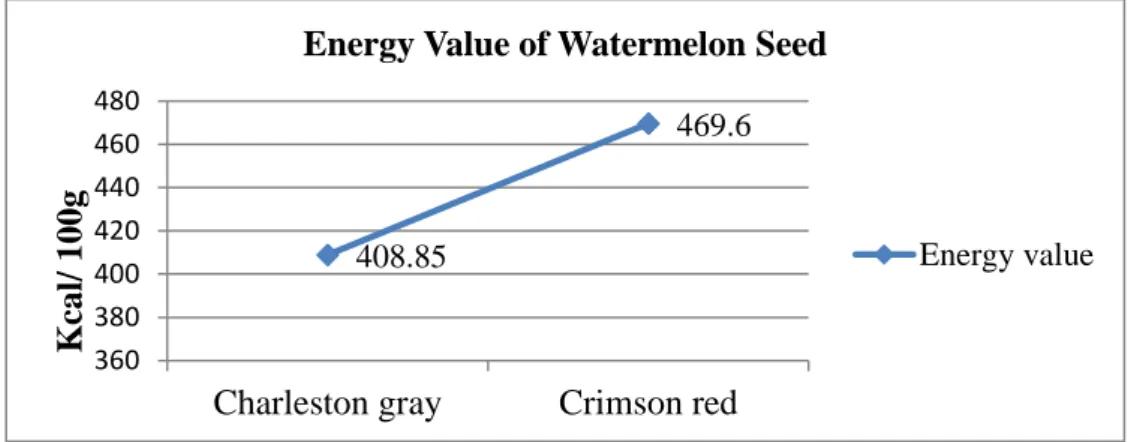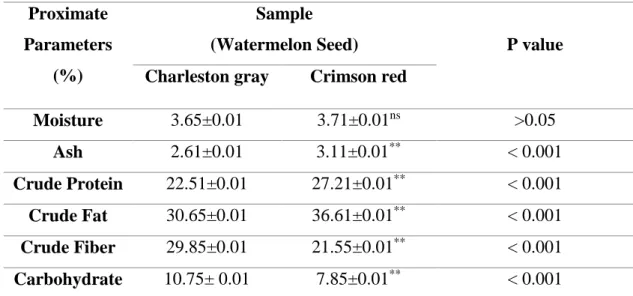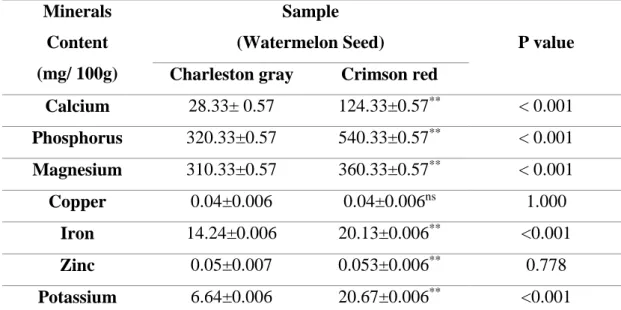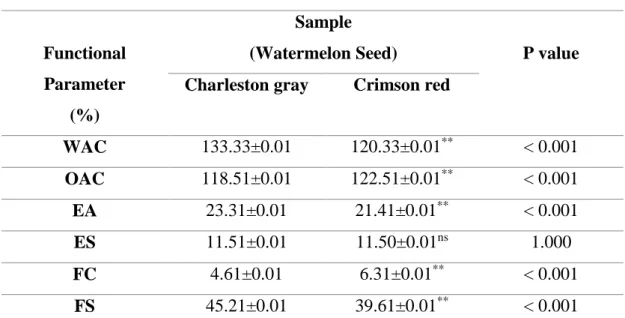To evaluate the nutritional composition of two varieties of watermelon seeds (Crimson red and Charleston gray). 2016) evaluated the nutritional composition of three types of watermelon seeds such as Charleston gray, Crimson sweet and Black diamond. Hannah and Krishnakumari (2015) evaluated the mineral content of watermelon seed extract and ash.
From the analysis, it was found that both the seed extract and the ash sample of watermelon seeds were rich in calcium. 2016) conducted a study to estimate the chemical properties of three types of watermelon seeds (Charleston gray, Crimson sweet and Black diamond). They revealed that the content of calcium, magnesium, potassium, phosphorus and copper was almost the same in three types of watermelon seeds.
A research study was conducted by Marie et al. 2015) to estimate the functional properties of four varieties of watermelon seed flour. The protein of watermelon seeds consists of different types of amino acids such as leucine, glutamic acid, arginine (Mello et al., . 8 | P a g e 2001). The present study on "Comparative evaluation of nutritional composition and functional properties of two varieties of watermelon seeds in Bangladesh" was conducted in the year 2019.
Two varieties of watermelon seeds such as Crimson red (black color seed) and Charleston gray (brown color seed) were collected from the local seed supplier of Chattogram, Bangladesh.

Moisture Content
The proximate composition of watermelon seed powder such as moisture, ash, crude protein, crude fat, crude fiber was determined in triplicate by liquid AOAC method (AOAC, 2005).
Ash Content
The energy value of the seed was calculated according to the formula used by Nile and Khobragade (2009). After separation, 20 ml of distilled water was added to the contents and transferred to a distillation flask. The distillate was titrated with N/10 HCl solution and the titration volume of the solution was recorded and the titration volume was calculated.
The percentage of crude protein was calculated according to the following formula, where the protein factor is 6.25. After the end of the extraction period, the extraction flask was removed and placed on a water bath for drying. The flask was then placed in a convection oven to heat at 100℃ until the exact weight was obtained.
Finally, the flask was placed in a desiccator for cooling and the mass of the ether extract was determined.
Crude Fiber Content
Carbohydrate was estimated by subtracting the percentage of moisture, ash, crude protein, crude fat and crude fiber from 100 according to the subtraction method.
Energy Value
Determination of Minerals Content of Watermelon Seed
- Sample Preparation
- Calcium (Ca) Content Principle
- Potassium (K) Content Principle
- Magnesium (Mg) Content Principle
- Phosphorus (P) Content Assay
- Zinc (Zn) Content
The intensity of the turbidity is directly proportional to the potassium concentration in the sample. The intensity of the color formed is proportional to the iron concentration in the sample. Magnesium ion reacts with xylidyl blue in alkaline solution to form a purple colored complex and complexes with calcium ion in the presence of GEDTA.
In an acidic medium, ceruloplasmin releases copper, which reacts with Di-Br – PAESA to form a colored complex. The intensity of the complex formed is directly proportional to the amount of copper present in the sample. Principle: In an alkaline medium, zinc reacts with Nitro – PAPS and forms a purple colored complex.
The intensity of the complex formed is directly proportional to the amount of zinc present in the sample.
Determination of Phytochemical Compound of Watermelon seed
Crude Alkaloids Content
Saponin Content
Determination of Functional Properties of Watermelon Seed
- Water Absorption Capacity (WAC)
- Oil Absorption Capacity (OAC)
- Emulsion stability (ES)
- Foam Capacity and Stability (FC and FS)
The stability of the emulsion was determined after heating the emulsion in a calibrated centrifuge tube for 15 minutes at 85°C in a water bath, allowing it to cool for a few minutes and centrifuged again for 5 minutes at 1500 rpm. The volume of seed powder was recorded and 100 ml of distilled water was mixed with the sample. The mixture was then shaken for several minutes to obtain foam and the foam volume was recorded. Foam stability was estimated by recording foam capacity at 10, 30, and 60 minute intervals.
All data obtained from estimation of the proximate composition, mineral content, phytochemical compound and functional properties of watermelon seed powder were entered into Microsoft Excel 2007 spreadsheet for statistical analysis. Data were assessed for statistical significance using independent sample 't' test for comparison of mean values, where n=3 obtained from triplicate test for each sample. The statistical data analysis was performed at 5% level of significance, where P< 0.05 the mean value difference is significant and P> 0.05 indicated that mean value difference is not significant.
Chapter-4: Results
- Proximate Composition of Watermelon Seed
- Minerals Content of Watermelon Seed
- Phytochemical Compounds of Watermelon Seed
- Discussions
- Proximate Composition of Watermelon Seed
- Minerals Content of Watermelon Seed
- Phytochemical Compound of Watermelon Seed
- Conclusion
- Recommendations & future perspectives
Table 4.3 shows the mineral content in mg/100 g for two varieties of watermelon seeds (Charleston gray and Crimson red). The result of functional properties for two varieties of watermelon seed showed that the seeds of both varieties of watermelon have good functional properties. The approximate percentage component for the two varieties of watermelon seed was shown in Table 4.1. In this study, the moisture content of two varieties of watermelon seed was found to be 3.65% for Charleston gray and 3.71% for Crimson red.
In the present study, it was found that the ash content of the two types of watermelon seed was 2.61% for (Charleston gray) and 3.11% for Crimson red. The percentage of protein found in this analysis for the two types of watermelon seed was 22.51% for the gray Charleston variety and 27.21% for the Crimson red variety. This analysis showed that the Crimson Red variety of watermelon seed contained a greater amount of protein than that of the Charleston Gray variety.
In this experimental study, the fat content of two varieties of watermelon seed was found to be 30.65% for Charleston gray variety and 36.61% for Crimson red variety. The result showed that both varieties of watermelon seed contained high amounts of fat or lipid, but the fat content of the seed of the Red Red variety was higher than the Gray Charleston variety. In this analytical study, the energy value found for the two varieties of watermelon seed is presented in figure 4.2 where Kcal/100g was found for the Charleston gray variety and 469.60±0.01Kcal/100g for the Crimson red variety.
The mineral content in mg per 100g for the two varieties of watermelon seed is shown in Table 4.3. The Phytochemical components in percentage (%) for the two varieties of watermelon seeds are shown in Table 4.4. In this research study, the results showed that two varieties of watermelon seeds contain phytochemical compounds such as crude alkaloid in a large amount and saponin in an insignificant amount.
The functional properties in percentage (%) for the two types of watermelon seed are shown in Table 4.5. The present study evaluated the nutritional, phytochemical and functional properties of two types of watermelon seeds. The result found for the analysis of functional properties of the watermelon seed revealed that the two types of watermelon seed had good functional characteristics.
The present study was conducted to analyze the nutritional profile, phytochemical composition and functional properties of watermelon seed. Comparative studies on the physicochemical and sensory properties of watermelon (Citrullus lanatus) and cantaloupe (Citrullus vulgaris) seed meal used in the preparation of egusi soup.

Processing of Watermelon Seed
Brief Biography


